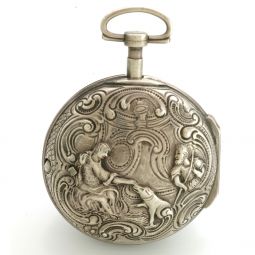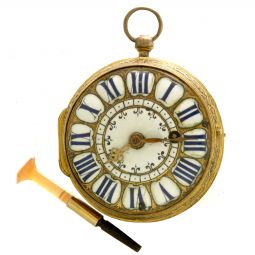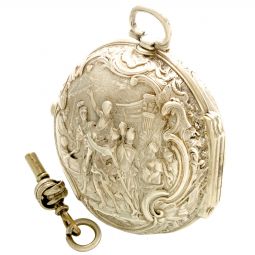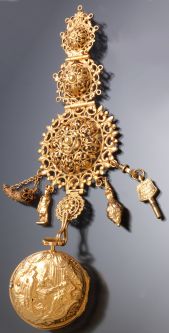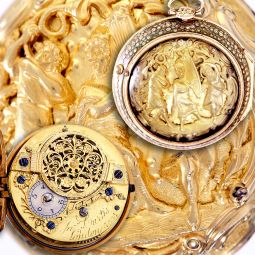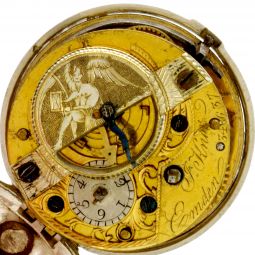Antique Silver Pair Case Quarter Hour Repeater Jodin Pocket Watch
183-33BS

Product Details
Early Antique Silver Pair Case Quarter Hour Repeater JodinPocket Watch
England; Jodin; Man’s; Serial# 130; C. 1690
Complications: ¼ - hour repeater.
CASE: The .800 silver, 56mm, pair case feature floral, repousse and pierced decorations.
DIAL: This white porcelain dial displays Roman numerals and Louis XIV hands.
MOVT: This key-set movement with verge escapement is gilt with a full plate layout and is signed.
C 3 (The case is in very good condition)
D 3-57 (The dial is in very good condition, slightly restored)
M 3 (The movement is in very good condition)
R 9 (Rarity on a scale of #1 being very common to #10 being extremely rare)
Experts Opinion: Both cases have elegant pierced designs with the outer case having a centered raised repousse motif on the back. BS
Quarter Hour Repeater
The quarter repeater strikes the number of hours, and then the number of
quarter
hours since the last hour. The mechanism uses 2 chimes of different
tones. The
low tone usually signals the hours, and the high tone the quarter
hours. As an
example, if the time is 2:45, the quarter repeater sounds 2 low tones
and after a
short pause 3 high ones: "dong, dong, ding, ding, ding". Alternatively,
some use a
pair of tones to distinguish the quarter hours: "dong, dong, ding-dong,
ding-dong,
ding-dong"
Verge Fusee Escapement
Used in antique spring-powered mechanical watches and clocks, a fusee is
a cone-shaped pulley with a helical groove around it, wound with a cord
or chain which is attached to the mainspring barrel. Fusees were used
from the 15th century to the early 20th century to improve timekeeping
by equalizing the uneven pull of the mainspring as it ran down. The
mainspring is coiled around a stationary axle (arbor), inside a
cylindrical box, the barrel. The force of the spring turns the barrel.
Key-wind/Key-set Movements
The very first pocket watches up until the third quarter of the 19th
century had key-wind and key-set movements. A watch key was necessary
to wind the watch and to set the time. This was usually done by opening
the case back and putting the key over the winding-arbor (which was set
over the watch's winding-wheel, to wind the mainspring) or by putting
the key onto the setting-arbor, which was connected with the
minute-wheel and turned the hands. Some watches of this period had the
setting-arbor at the front of the watch, so that removing the crystal
and bezel was necessary to set the time.
This watch includes a reproduction of the correct size key, it is not
the original.
Pair Case
Higher end early verge fusee watches were often in a pair case. Pair
case refers to when a pocket watch is placed within another case
(nesting), therefore two cases.

